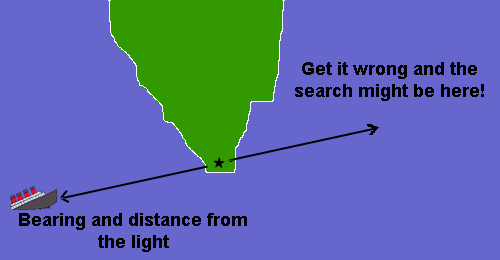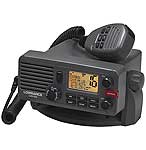Distress on small vessels at sea
When are you in distress?
The definition of being in distress is that there is:
Grave and imminent danger to life or the vessel
This includes, sinking, fire, being swept towards a hazard, man over board and serious medical emergencies.
The majority of Mayday calls I hear are probably not within the above classification, most are breakdowns that should really be classed as Urgent situations, ones that require a Pan Pan call. However if I was on the boat concerned I might feel differently!
As a general rule, if you chose to go to sea you should accept responsibility for looking after yourself and your crew. This means that when a real seaman has a problem, he will do everything possible to fix it prior to calling for help.
There are some exceptions:
- Fire - you may not get a chance to make the call later.
- Man over board - when I practice with experienced sailors recovering a body from the water onto the deck of a yacht at sea, it never takes less than 20 minutes. In a popular yachting area such as the Solent, a helicopter could have the casualty in hospital in that time, and they carry heat seeking equipment that enables them to see a person in the water more easily than we can from the deck of a yacht.
- When it will soon be dark - if a rescue will be necessary it is much easier to perform if you have been found in daylight.
In all of the above situations if you are able to resolve the problem with out outside assistance you can call up and cancel the Mayday. However, always remember that the rescue services may be engaged elsewhere and it may be some time before you will receive any real help.
Distress signals
Annex IV to the International Regulations for the Prevention of Collisions at Sea covers the internationally recognised distress signals. Some are ideal for small craft, whilst others may be irrelevant to your specific situation. A prudent skipper will make sure that there are a variety of options available if necessary.
Mobile phones
The use of mobile phones in rescue at sea has several problems.
- The coastguard can not fix your position by Radio Direction Finding
- You can only talk to one person at a time
- You can not alert all the stations in your vicinity to your problem
- Close to a craggy coast you may not be able to get a signal (Dorset coast near Lulworth Cove)
Mobile phones have proved invaluable to yachtsmen but save them for booking your restaurant table and do not rely on one for calling for help.
Sending a Mayday message
When sailing in coastal waters, probably the most effective means of indicating that you are in distress is to transmit a Mayday call by VHF radio. A Mayday call tells everyone in the area that you are in trouble and under the SOLAS V regulations, obliges them to come to your assistance if possible, but it also imposes radio silence to prevent your messages being covered up.
The sequence of the message is fairly obvious:
- Tell people you are in trouble
- Who you are
- Where you are
- What the problem is
- Assistance you need
- People on board
- Let them reply
If you are unable to complete the message for any reason, the important information has been sent first.
Normally a Mayday is sent on channel 16, this is the distress and calling channel on VHF radio but any other channel can be used, high power (25W) should be selected.
The format is;
Mayday, Mayday, Mayday
This is Irina, Irina, Irina,
Mayday Irina,
My position is 50°10.3'N 01°45.3'.W
We are on fire and require immediate assistance
5 people on board
Over
Then wait for a reply!
When you give your position there are two options:
Latitude and longitude
The advantage of this method is that most boats have a GPS navigation system next to the radio. For one of the crew to send a Mayday, they only need to know the sequence (which can be read off a procedure card kept alongside the radio) and how to find the position of the vessel from the GPS. The skipper can then delegate this job to someone who does not know how to navigate, if that is appropriate.
If you are in the vicinity of Eastbourne, make sure you know if you are east or west of Greenwich!
Bearing and distance
The advantage of using a bearing and distance to describe your position is that anyone hearing you knows approximately where you are in relation to them, but it does take some navigation skill to use. With a bearing and distance, the direction is always given from the reference point not from the vessel!

Another benefit of using a bearing and distance from a know point is that it is much easier to remember. In a real situation, it is likely that someone on deck will hear the start of a Mayday call, and then need to get to the chart table to record the information. It is far easier to remember something like "3 miles south of the Needles Lighthouse" that a latitude and longitude (50° 36.70' N 01° 35.42' W).
To train the crew in radio use, they should be encouraged to use the radio (under supervision) to contact any marinas that you call, rather than the skipper always doing the radio work.
Everyone who sails regularly should have attended a course in the use of VHF radios. The course and exam is normally one day and is suitable for people at all levels of yachting experience.
Candidates for the Yachtmaster Coastal and Offshore exams must hold a VHF operator's certificate.
Phone 023 80 45 77 33 to book a course and exam.
DSC VHF radios
Most radios fitted to yachts today are DSC radios. The DSC system is part of the Global Maritime Distress and Safety System (GMDSS).
A DSC controller on a VHF radio allows you to trip an alarm on any vessel that receives your signal, this alarm is intended to alert all stations to your distress.
on any vessel that receives your signal, this alarm is intended to alert all stations to your distress.
Included in the DSC signal is;
- The unique code the identifies your vessel, the Mobile Maritime Service Identity (MMSI)
- Your position
- The time when you were at that position
- And possibly the nature of your problem
The real benefits of DSC are that:
- This alert prepares people for the voice mayday that you will send
- It gives your position
- The signal takes a very short time to send
- The alarm will continue until is manually stopped on each vessel that receives it - even several hours later!
- The digital signal of DCS has the potential to be detected over a greater area than a message sent by voice
If you send a DSC alert prior to sending a voice mayday, always add the vessel's MMSI after its name. This will tie the two messages together.
As with all safety equipment, learn how it works before you need it, you do not want to be reading the manual as the water is flowing over the top of your sea boots!
Save money buying your radio equipment online.
Sailtrain.co.uk is free to use, but if you feel you would like to contribute to the running and development costs you can donate via Paypal:
Additional Resources:

